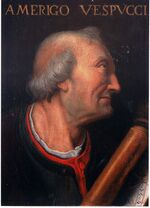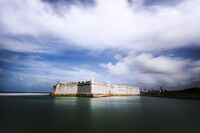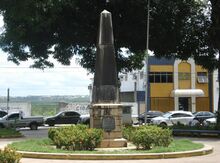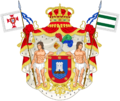Kingdom of Quinta Velha
Kingdom of Quinta Velha Reino de Quinta Velha | |
|---|---|
| Motto: "Nós depois de vós" "We after you" | |
| Capital and largest city | Santiago do Sacramento 05°47′S 35°12′W / 5.783°S 35.200°W |
| Official languages | Portuguese |
| Ethnic groups (2023) | White(44%) Mixed race(41%) Black(15%) |
| Religion (2023) | Roman Catholic (59%) Spiritist (8%) Candomblé (5%) Atheism (5%) Agnosticism (3%) Islam (3%) |
| Demonym(s) | Quintavelhense |
| Government | Autocratic constitutional monarchy |
• King | Thomas I |
| Legislature | General Cortes |
| Independence from the Federative Republic of Brazil | |
• Foundation | 05 November 2018 |
• Reorganization | 2019 |
| 12 March 2020 | |
| 07 April 2020 | |
| Population | |
• 2023 estimate | 39 |
| HDI (2021) | ▲ 0.763 high · 85th |
| Currency | CS Doubloon (Δ$) Line (£$) (CSD) |
| Date format | dd/mm/yyyy |
| Driving side | right |
| Calling code | +55 |
| Internet TLD | .qv |
| |
Quinta Velha, officially Kingdom of Quinta Velha (Portuguese: Reino da Quinta Velha) is a self-proclaimed state, commonly known as a micronation, located in South America and bordering Brazil and the United Provinces of Mauritia. It is an enclave in the Brazilian state of Rio Grande do Norte. With a land area of approximately 0.678 ha (0.01 km²) and a population of 39 citizens, the Kingdom's territory is divided into six provinces. The Capital is Santiago do Sacramento, which is also the most populous province. Portuguese is the official language of Quinta Velha. With a multi-ethnic population, the culture of the Kingdom is influenced by the Northeast region of Brazil and also by Portuguese and italians traits present in the colonial history of the region.
Quinta Velha is an Autocratic constitutional monarchy, where all powers are concentrated in the figure of the King, who acts as Head of State and Government. The King has the prerogative to convene the Sovereign Congress to serve as the Legislative House in matters of high importance.
Etymology
The kingdom's name derives from an old rural property located in the Quintas neighborhood, in the city of Natal, Rio Grande do Norte, Brazil. Still during the Brazilian colonial period, a farm belonging to Portugueses located where the kingdom would be founded, was called "Quinta Velha". In this very neighborhood is located one of the most important territories of the Kingdom, which was named "Quinta Velha" in honor of this historic passage in the west zone of the city of Natal. From 2018 to 2021, it served as the capital of the kingdom, and still is its most populated city.
National symbols
-
Flag
-
Greater Arms
-
Small Arms
History

The first European to reach the region that would become Quinta Velha may have been the Spaniard Alonso de Ojeda, in 1499. The northeastern tip of South America, Cape São Roque, 20 miles (32 km) to the north of Natal, was first officially visited by European navigators in 1501, in the 1501–1502 Portuguese expedition led by Amerigo Vespucci, who named the spot after the saint of the day. The Vespucci expedition also named the Potengi (Tupi for "River of Shrimps") river, whose considerably large mouth contrasted with the nearby bodies of water, "Rio Grande" (Portuguese for "Great River"), after which the Captaincy, Province, and State were named. For decades thereafter, no permanent European settlement was established in the area, inhabited by the Potiguar tribe.

In the 16th century (between 1535 and 1598), the area was explored by French pirates in search for Brazilwood. In 1598, the Portuguese built the Three Wise Man Fortress and, in the following year, founded the city of Natal. Rasing cattle and sugarcane plantation lifted the local development and economy.[1]
In 1597, after some years during which French pirates led by Jacques Riffault, established regular commercial activities with the native population, the ninth Portuguese Governor-General of Brazil, Francisco de Sousa, ordered the expulsion of the buccaneers. The successful expedition against 50 Frenchmen and their amerindian allies was led by the Captain-Major of the Captaincy of Pernambuco, Manuel de Mascarenhas Homem, with the assistance of Jerônimo de Albuquerque Maranhão.

Albuquerque Maranhão began on 6 January 1598, the construction of the Fort of the Holy Kings or of the Magi-Kings ("Forte dos Santos Reis" or "Forte dos Reis Magos"), named after the Three Wise Men, honored in the Christian feast of the Epiphany, celebrated on that day.
The neighbor city of Natal (which translates to "Nativity" or "Christmas" in Portuguese) was founded on 25 December 1599, giving the village outside the fort the modern name of the city and as consequence, to the territory that eventually would be declared a sovereign kingdom.[2] The fort, city, and surrounding areas were occupied by Dutch forces from 1633 to 1654. They rechristened the fort "Fort Ceulen" after one of their commanders. The sandy soil of Natal prevented the city from becoming a producer of sugarcane during the colonial times. For centuries, the economy of the state was based on the raising of cattle in the dry interior lands.
In the last century, the area benefited from the growth of the salt industries (the north of Rio Grande do Norte is the largest producer in Brazil) and petroleum (the largest inland Brazilian reserves are in the State). It grew quickly, but in a somewhat planned way (compared to other major Brazilian cities). Tourists (first Brazilians, more recently foreigners) discovered the city, which became one of the major tourist destinations in Brazil.

Because of its strategic position (Natal is one of the cities in Brazil nearest to Western Europe and Africa, especially Dakar, Senegal), an American air base was built in a suburb of Natal named Parnamirim during World War II, as part of the so-called Operation Rainbow. This base provided support for allied troops fighting in north Africa. Thousands of American soldiers were sent there and their presence left traces in the culture of the region until today. The city also held the Potenji Conference, which took place right after the Casablanca Conference and defined the active participation of Brazil in the war, being the only Latin American country to send troops overseas to fight in Europe.
The Foundation of the Kingdom

The Kingdom of Quinta Velha is the successor state of the Senhorio das Terras de Santa Rita de Cássia (English: Lordship of the Lands of Saint Rita os Cascia), a Brazilian micronation founded on 05 November 2018 and whose territory was the properties belonging to the Albuquerque family on Santa Rita beach, on the coast of Rio Grande do Norte. After gaining rights to the properties of his wife's family, Thomas I, then Lord of the Lands of Saint Rita, united two private properties in the Natal region and elevates the Lordship to the status of Kingdom, becoming the first King of Quinta Velha.
In its early years, the Government of Quinta Velha dedicated itself to creating the necessary structures for the governance of the country. The first government bodies were created, the national currency was created - the Line - and an effort was made to rescue historical and cultural values for the creation of a national identity, headed by the Historic Institute of Quinta Velha. In 2019, the first census of Quinta Velha was carried out, to understand more deeply the characteristics of the population.
Consolidation
Once the administrative structure of the kingdom was established, the National Government decided to open its diplomacy to other micronations and, in 2020, Quinta Velha ratified the Treaty of Persenburg, inserting itself in the Brazilian sector of micronations and entering the fight for the promotion of Brazilian derivatives. Then the Protocol of Goetha and the Convention of Mauritsstad were ratified, evidencing the political position of Quinta Velha and its King. The Kingdom's greatest diplomatic achievement was the founding of the Conference of Santiago, the main organization of micronations in Latin America, created from the Treaty of Santiago, written by King Thomas I.
In 2021, more internal changes were made. The Government worked on the restructuring of the territorial division of Quinta Velha and the capital was changed, leaving the Province of Quinta Velha and passing to the Province of Santiago do Sacramento. The Government also changed its headquarters, moving to the Duque de Sena Palace.
In the following year, Quinta Velha increased its influence on the international scenario, signing diplomatic recognitions with important micronations around the world and actively participating in diplomatic activities. In addition, a fourth province was created in the Kingdom, the province of Bom Jesus dos Navegantes, guaranteeing one more outlet to the sea and serving as a base for the Royal Armada. In August, Quinta Velha ratified, along Karnia-Ruthenia and Ebenthal, the Treaty of Altenburg, creating a defensive alliance between the three countries. Subsequently, King Thomas I was elected the third Secretary-General of the Conference of Santiago, actively working to solve the diplomatic crisis involving Karnia-Ruthenia and Ebenthal regarding Roschfallen and developing part of the Conference's information apparatus.
Geography

Quinta Velha is located at the far east of South America and lies on the Atlantic Ocean, at the mouth of the Potengi River and its location is considered strategic due to its proximity to Europe, Africa and Central and North America. It's an enclave in the Brazilian cities of Natal and Extremoz, in Rio Grande do Norte. It also has a province in Portuguese territory, in the Castro Daire region. Not far from Quinta Velha, the relief consists of coastal plains with a vast presence of dunes. There is also a considerable presence of mangroves. The main river in the country is the Potengi River, which bathes part of the province of Quinta Velha and is the main river in the region. The vegetation cover is formed by the Atlantic Forest, with constant points of preservation. It also has a rich diversity in its fauna and flora, consisting of several species of animals and plants.
Climate
Quinta Velha has a typical tropical climate, specifically a tropical wet and dry climate (Köppen climate classification: As), with warm to hot temperatures and high relative humidity all throughout the year. However, these conditions are relieved by a near absence of extreme temperatures and pleasant trade winds blowing from the ocean. February is the warmest month, with mean maxima of 31 °C or 87.8 °F and minima of 24 °C or 75.2 °F, while July is the coolest with mean maxima of 28 °C or 82.4 °F and minima of 21 °C or 69.8 °F. Rainfall is heavy at around 1,720 millimetres (68 in) per year, but there is a dry season between about September and January that is more distinct than further south on the Atlantic coast. The greatest amount of rain falls between March and July.[3]
| Climate data for Quinta Velha | |||||||||||||
|---|---|---|---|---|---|---|---|---|---|---|---|---|---|
| Month | Jan | Feb | Mar | Apr | May | Jun | Jul | Aug | Sep | Oct | Nov | Dec | Year |
| Record high °C (°F) | 33.4 (92.1) |
33.2 (91.8) |
33.8 (92.8) |
33 (91) |
32.4 (90.3) |
32.2 (90) |
30.8 (87.4) |
31.2 (88.2) |
30.8 (87.4) |
32 (90) |
32.1 (89.8) |
34 (93) |
34 (93) |
| Average high °C (°F) | 30.4 (86.7) |
30.6 (87.1) |
30.6 (87.1) |
30.2 (86.4) |
29.7 (85.5) |
28.7 (83.7) |
28.3 (82.9) |
28.4 (83.1) |
29 (84) |
29.8 (85.6) |
30 (86) |
30.3 (86.5) |
29.7 (85.5) |
| Average low °C (°F) | 24.3 (75.7) |
24.3 (75.7) |
24 (75) |
23.3 (73.9) |
22.7 (72.9) |
21.5 (70.7) |
20.7 (69.3) |
21 (70) |
22 (72) |
23.3 (73.9) |
24 (75) |
24.4 (75.9) |
23 (73) |
| Record low °C (°F) | 18.4 (65.1) |
19 (66) |
18.2 (64.8) |
18 (64) |
18 (64) |
17 (63) |
16.4 (61.5) |
15.4 (59.7) |
16.6 (61.9) |
17.4 (63.3) |
17.9 (64.2) |
18.4 (65.1) |
15.4 (59.7) |
| Average Precipitation mm (inches) | 61.1 (2.406) |
94.4 (3.717) |
203.3 (8.004) |
272.2 (10.717) |
236.2 (9.299) |
353.6 (13.921) |
242.2 (9.535) |
134.7 (5.303) |
47.7 (1.878) |
22.1 (0.87) |
28.4 (1.118) |
25.5 (1.004) |
1,721.4 (67.772) |
| Average relative humidity (%) | 78.2 | 78.5 | 80.1 | 82.8 | 82.7 | 84.5 | 82.8 | 80.5 | 78.6 | 76.9 | 77.8 | 78.4 | 80.2 |
| Average precipitation days (≥ 1 mm) | 7 | 8 | 14 | 17 | 15 | 19 | 16 | 14 | 8 | 4 | 4 | 5 | 131 |
| Sunshine hours | 259 | 226.4 | 234.4 | 208.7 | 224.8 | 198.6 | 215.4 | 245 | 264.4 | 291.9 | 279.2 | 284.3 | 2,932.1 |
| Source: Brazilian National Institute of Meteorology (INMET) (normals 1981-2010;[4] extremes: 1 Jan 1961-31 Dec 1970, 1 Aug 1983-31 Dec 1984, 1 Jan 1986-present)[5][6] | |||||||||||||
Demographics
Quinta Velha has a population of 39 citizens. Among the religions practiced are Roman Catholicism (59%), Spiritism (8%), Candomblé (5%), those who consider themselves atheists are 5% of the population and those who say they are agnostics add up to 3% of the population. 44% of the population self-declared as white, while 41% consider themselves brown and 15% self-declare as black.
Government and politics
The Kingdom is defined as an autocratic constitutional monarchy, with the King as Head of Government and State. Legislative power is exercised by the General Cortes, convened by the King and formed by elected deputies in all the provinces of the Kingdom. National justice is conducted by the Supreme Court of the Kingdom.
Law
For matters of extreme importance, the King may summon the General Cortes, formed by deputies elected for this purpose and who serve as an Advisory Council to the King on a predetermined agenda. This institute is convoked on necessity, with no regular activity as a parliament.
In general, most of the most complex and nationally influential decisions are made in consultation with these institutions. More ordinary matters are resolved only by the National Government and by the person of the King.
Foreign relations

Quinta Velha foreign affairs are conducted personally by the King, along the Minister of State for Foreign Affairs. The Kingdom has become an important force in the Brazilian and South American micronational scene, with King Thomas often recognized as a skilled statesman and diplomat. Throughout its history, Quinta Velha adopted a peaceful diplomatic position and cooperation with its allies, while always acting in a harsh way in the face of threats. In all diplomatic crises, Quinta Velha acted to be at the forefront of the actions taken in the conflicts.
In 2020, during the movements for the formation of the Brazilian sector, the King of Quinta Velha articulated the foundation of an international cooperation organization that would bring together derivative micronations. He authored in April 2020 the Treaty of Santiago, which officially founded the Conference of Santiago, that would become the main micronational organization in South America.
In 2022, together with Ebenthal and Karnia-Ruthenia, Quinta Velha ratified the Treaty of Altenburg, forming a defensive alliance between the countries. Since then, Saint Joseph Fortress has nominally served as the General Headquarters for the meetings of what is used to be called the Altenburg Pact. In the same year, the King of Quinta Velha was elected Secretary-General of the Conference of Santiago, acting in the mediation of diplomatic conflicts, working for the growth of the organization.
Quinta Velha maintains cordial diplomatic relations with several micronations around the world, working mainly for micronational integration and for the promotion of Brazilian micronationalism at an international level, consolidating itself as one of the main names in the Brazilian sector. It is considered a major power within the Brazilian sector, a regional power in South America and a small power with emerging potential within the international community of micronations.
The headquarters of the Ministry of Foreign Affairs is known as The Annex Room, because it is located in a room at the Albuquerque Manor (Portuguese: Solar de Albuquerque), in Saint Rita.
Military
The national ground forces is called the National Guard of Quinta Velha, organized into four headquarters: the first in the Province of Quinta Velha, the second in Santa Rita, the third in Santiago do Sacramento and the fourth in Bom Jesus dos Navegantes. The National Guard's main activity is to monitor activities in the digital territories of Quinta Velha, ensuring the safety of citizens and preventing cyber attacks, as well as joint defense and attack operations with allied ground forces.
The kingdom also has an active secret service, called the Homeland Security Service of the Kingdom of Quinta Velha. Its main function is to provide intelligence and counter-intelligence activities, ensuring the collection of information from enemies and elements with the potential to become a nuisance for Quinta Velha.
The Royal Armada of Quinta Velha is the naval force of Quinta Velha. It was created after the incorporation of the territory of the province of Bom Jesus dos Navegantes, which began to serve as a base for the fleet of the Armada. It currently has five vessels: NSM. Santa Rita, NSM. Santiago, NSM. Albuquerque, NSM. Crown Prince and the NSM. Queen Amanda.
Since its creation, the armed forces of Quinta Velha were involved in the events of the Santiago-Mansean conflicts, actively acting in the military efforts of that context.
Administrative regions
Quinta Velha is a unitary state divided into six autonomous provinces. Each province is governed by a Governor appointed by the King. There is no subdivision of provinces. The national territory is formed by private properties belonging to the family of King Thomas, or by supplementary territorial collectivities, properties whose sovereignty is ceded by their owners. The territory is divided into the following provinces:
| Flag | Arms | Region | Code | Population | Area (m2) | Official language(s) | Government | Governor | |||
|---|---|---|---|---|---|---|---|---|---|---|---|
| Provinces | |||||||||||
| Santos Reis | SE | ~ | ~ | Portuguese | Executive-led administration | ||||||
| Santa Rita | SI | ~ | ~ | ||||||||
| Santiago do Sacramento | SS | 6 | ~ | ||||||||
| Bom Jesus dos Navegantes | JN | ~ | ~ | ||||||||
| São Sebastião das Águas de Quinta Velha | SA | ~ | ~ | ||||||||
| Herdade | HE | ~ | ~ | ||||||||
Economy

Quinta Velha has a mixed economy and a small internal market, on vias to develop a common market with the Conference of Santiago. The economy has been in a stable and controlled ascension, with the GDP per capita following on the same course. Active mainly in the service sector, Quinta Velha has an estimated labor force of over 19 people. The country has been expanding its presence in intermicronational financial markets specially through the development of the Conference of Santiago Common Market.
Major export products include manufactural goods, information technology and services. The country has two official currencies: The Line (£$) and the conferential doubloon, pegged to the pyrite standart (converted to Brazilian Real), following a managed-float monetary policy by the Conference of Santiago Financial Authority as an official currency.[7] Nonetheless, most of the country's business is done in Brazilian Real. The higher expenses of Quintavelhense economy are with welfare and infrastructure, followed by security, health and the environment. Spending on government manutention are minimal.
The Station Bank is the central bank of Quinta Velha, the highest authority and responsible for the monetary policy of the Kingdom. The issuance of paper money is carried out by the Royal Reserve, which also controls the monetary reserves of Quinta Velha.
Culture

The core culture of Quinta Velha is derived from Portuguese culture and its sub-product, the Brazilian culture, especially the one from northeastern Brazil. Carnival in the city of Natal, known as "Carnatal", is one of the largest off-season carnivals in Brazil and very popular among Quintavelhenses[8] and takes place sometime in November or December, in the streets around the Arena das Dunas Stadium (traffic around the stadium changes radically during Carnatal days).[9] During the days of party, a huge truck (called "trio elétrico"), with a band on the top and sound boxes all around, drives slowly along the streets. The crowd follows the trio elétrico singing, dancing, jumping to the sound of the music.
June Festival, known as Festa Junina, is also an extremely popular celebration in Quinta Velha. Celebrating the nativity of St. John the Baptist on 24 June, these festivities were introduced by the Portuguese during the colonial period.
Sports are also very common among Quintavelhenses. There is a prominent practice of skateboard, in addition to a growing popularity of Esports, more specifically shooting games and soccer. The most popular e-soccer team in Quinta Velha is the Ferroviário Football Club, a team from the Dream League Soccer platform and Micronational Footbal Confederation.
The literature is heavily influenced by Brazilian northeastern authors, such as Ariano Suassuna and Auta de Souza. There is also the production of national literature, highlighting the collection of chronicles "Lost Chronicles of Everyday Life" written and published by the King himself at the Chronicles of Riachuelo,[10] that also serves as the printed media with the greatest circulation in the territories of the Kingdom. The citizens of Quinta Velha use the TV and radio signals from Brazil. All territories are covered by an internet signal.
See also
External links
References
- ↑ Grande Enciclopédia Universal, page 11442, "Rio Grande do Norte" paragraph 1
- ↑ "Christmas in Natal - Natal em Natal". www.natal-brazil.com. Archived from the original on 2016-03-04. Retrieved 2015-09-21.
- ↑ Destination360.com. "Climate of Natal". Archived from the original on 16 April 2009. Retrieved 25 Jun 2012.
- ↑ Instituto Nacional de Meteorologia. "NORMAIS CLIMATOLÓGICAS DO BRASIL" (in português). Archived from the original on 5 September 2014. Retrieved 31 May 2018.
- ↑ Brazilian National Institute of Meteorology. "BDMEP - série histórica - dados diários - temperatura mínima (°C) - Natal" (in português). Retrieved 31 May 2018.
- ↑ Brazilian National Institute of Meteorology. "BDMEP - série histórica - dados diários - temperatura máxima (°C) - Natal" (in português). Retrieved 31 May 2018.
- ↑ The Conference of Santiago and the Conferential Doubloon. Retrieved on 21 August 2020. Published on 4 August 2020.
- ↑ "Carnatal". Natal-brazil.com. Archived from the original on 2012-05-11. Retrieved 2012-06-25.
- ↑ Carnatal Organization Archived 2014-08-14 at the Wayback Machine 12 June 2014
- ↑ Chronicles of Riachuelo official page, 26 April 2021.





